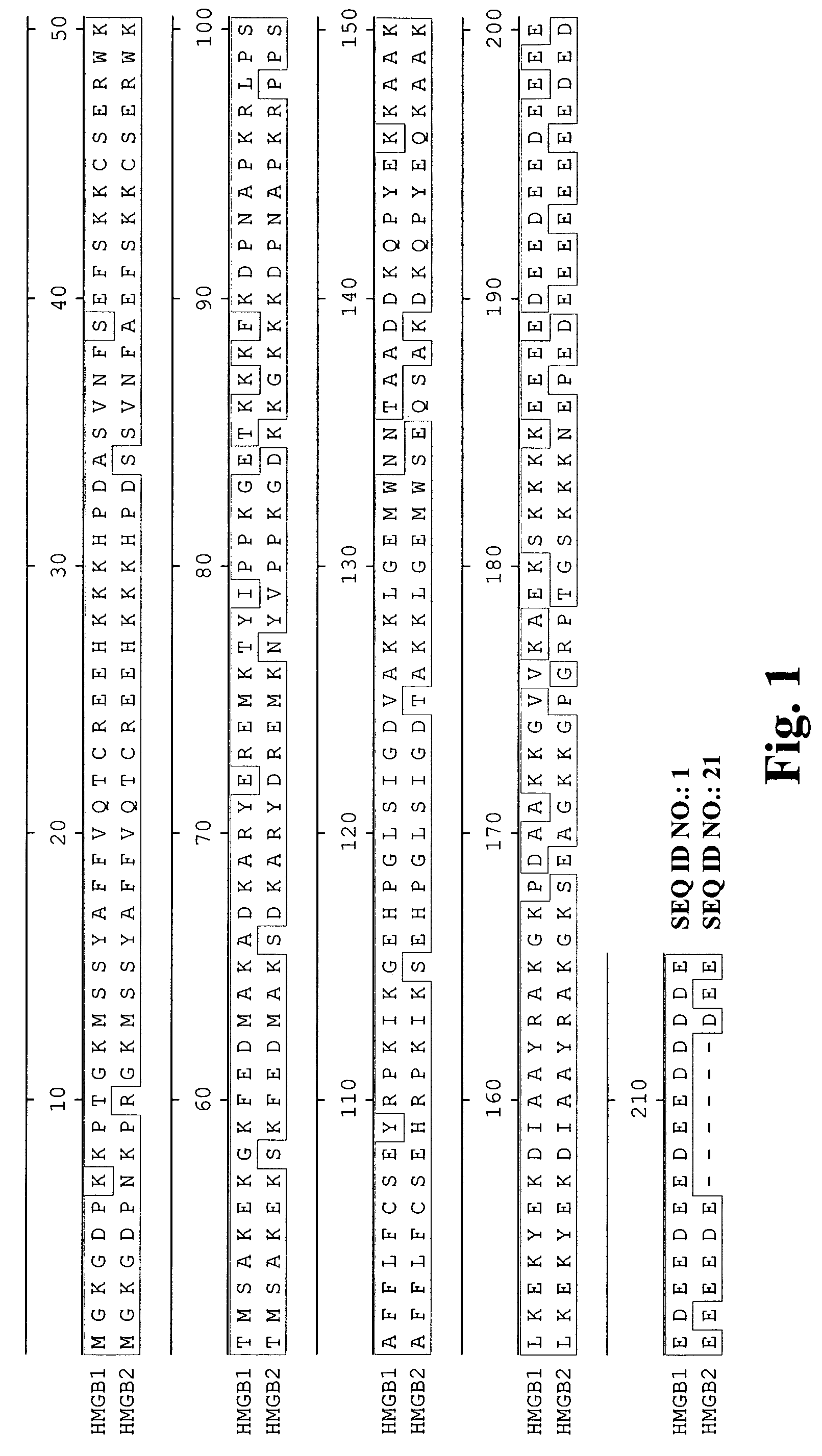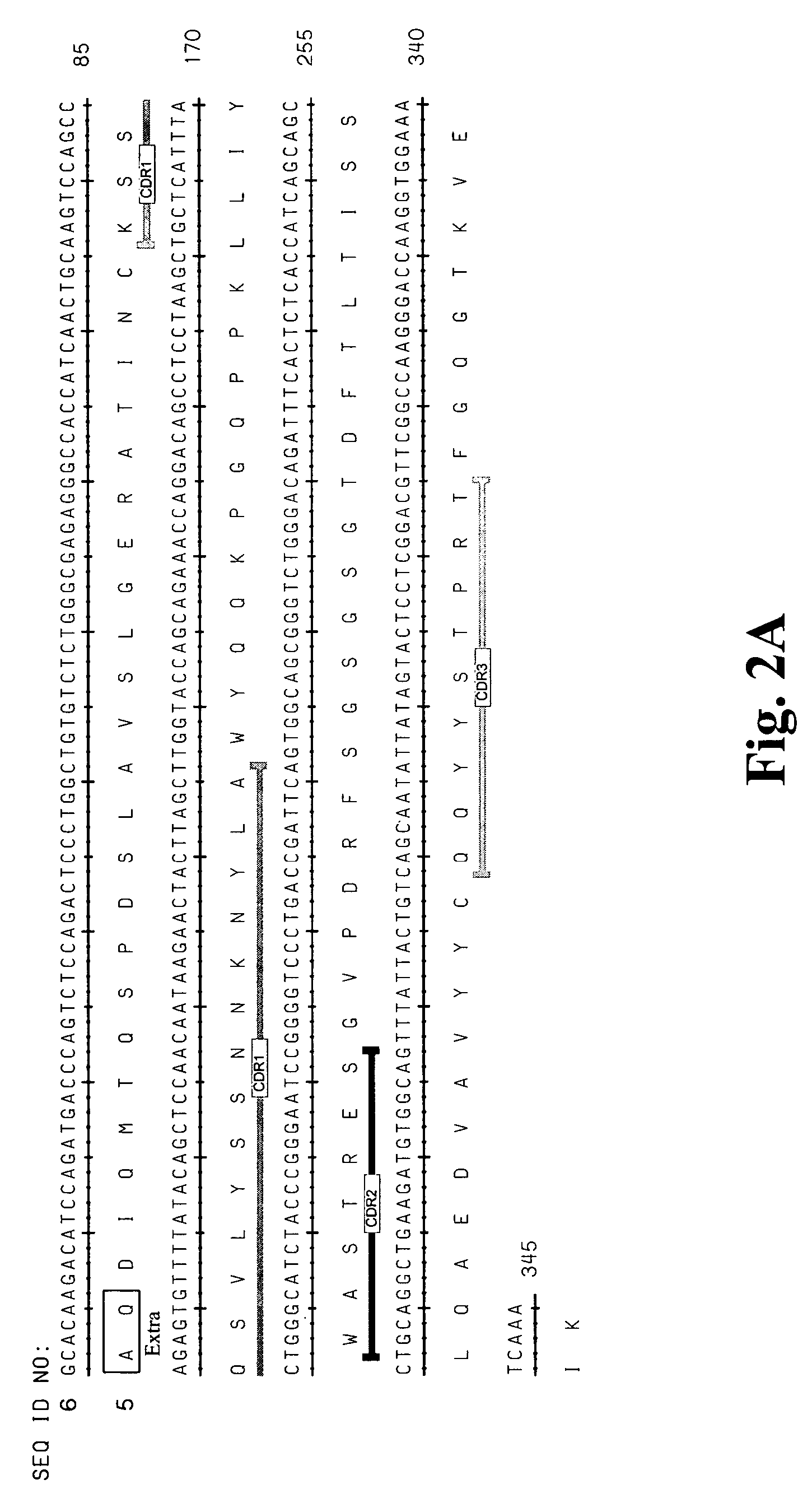High affinity antibodies against HMGB1 and methods of use thereof
a technology of high affinity antibodies and antibodies, applied in the field of high affinity antibodies against hmgb1, can solve the problems of elevated serum hmg1 levels that are toxic, and achieve the effects of reducing bone loss and/or cartilage damag
- Summary
- Abstract
- Description
- Claims
- Application Information
AI Technical Summary
Benefits of technology
Problems solved by technology
Method used
Image
Examples
example 1
7.1 Example 1
Development and Physical Characterization of Human anti-HMG1 Antibodies
[0310]A large panel of human anti-HMG1 antibodies were isolated from a naïve human Fab phage display library by several rounds of panning against human HMG1 (SEQ ID NO: 1 and 2, also see FIG. 1). The clones were then sequenced to eliminate duplicate clones and the Fab fragments were subcloned into an expression vector for the production of full length IgG. The nucleotide and corresponding amino acid sequences of the variable regions of the light and heavy chains of several antibody clones (G2, G4, G9, G 12, G 16, G20, G34, G35, S2, S6, S10, S12, S14, S16, S17 and E11) are provided in the sequence listing (see Table 3 for specific SEQ ID NOS.). FIG. 2 represents the variable regions of the heavy and light chains of several antibody clones (S2, S6, S16 and G4) that have been deposited with the American Type Culture Collection (deposit numbers PTA-6142, PTA-6143, PTA-6259 and PTA-6258, respectively). Al...
example 2
7.2 Example 2
Kinetic Analysis of Human anti-HMG1 Antibodies
[0316]The binding kinetics and specificity of several human anti-HMG1 antibodies was examined using a variety of techniques. In addition, several peptides were used in epitope mapping studies. As summarized in Table 1, these analysis show that the human anti-HMG1 antibodies have differing binding kinetics and specificity. In addition, the data indicate that the anti-HMG1 antibodies bind to a variety of epitopes including the HMG1 B-Box and A-Box.
[0317]7.2.1 Materials and Methods
[0318]Production / Isolation of Recombinant HMG1: Recombinant HMG1 is purified from E. coli as a calmodulin binding protein (CBP) fusion protein (CBP is fused to N-terminal end of HMGB1). E. coli expressing CBP-HMG1 are induced for 2-3 hours and the protein is release by microfluidization in 25 mM Tris-HCl, 150 mM NaCl, 2 mM CaCl2, pH 8.0. The lysed cells are centrifuged at 125,000×g for 1 hour, the filtered supernatant is applied to a calmodulin column...
example 3
7.3 Example 3
Anti-HMGB1 Antibodies Inhibit Cytokine Release from Human PBMC's
[0334]The ability of a panel of human anti-HMG1 antibodies to inhibit HMG1 induced cytokine release from human peripheral blood mononuclear cells (PBMCs) was determined. The effect on the following cytokines were examined, IL-12, IL-1β, TNF-α, and IL-6. A number of anti-HMG1 antibodies are capable of inhibiting the release of one or more of these cytokines induced by HMG1. In addition, it was determined that HMG1 can stimulate the release of NO and that antibodies against HMG1 can inhibit this release. The ability of several human anti-HMG1 antibodies to reduce HMG1 induced cytokine gene expression in mouse macrophages was also demonstrated.
7.3.1 Materials and Methods
[0335]Inhibition of Cytokine Release: Human peripheral blood mononuclear cells (PBMCs) were isolated from the peripheral blood of healthy volunteers by a density gradient centrifugation. Freshly drawn heparinized whole blood was mixed with two ...
PUM
| Property | Measurement | Unit |
|---|---|---|
| dissociation constant | aaaaa | aaaaa |
| dissociation constant | aaaaa | aaaaa |
| Tm | aaaaa | aaaaa |
Abstract
Description
Claims
Application Information
 Login to View More
Login to View More - R&D
- Intellectual Property
- Life Sciences
- Materials
- Tech Scout
- Unparalleled Data Quality
- Higher Quality Content
- 60% Fewer Hallucinations
Browse by: Latest US Patents, China's latest patents, Technical Efficacy Thesaurus, Application Domain, Technology Topic, Popular Technical Reports.
© 2025 PatSnap. All rights reserved.Legal|Privacy policy|Modern Slavery Act Transparency Statement|Sitemap|About US| Contact US: help@patsnap.com



